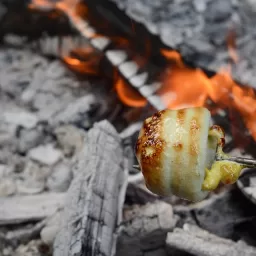Use Low Voltage Lighting to Brighten Up Your Backyard
Low voltage lighting is the most popular family of outdoor lighting options. And for good reason. It’s safe – it’s easy to install – and it does a great job.
Pros
Low voltage outdoor lighting is the most versatile style of lighting for most applications. The strength or intensity of the light can be varied by selecting higher or lower wattage bulbs, Since these systems are operated with only 12 volts, they are safe to work with. 12 volts will tickle a bit, but it won’t hurt you. You don’t need to be an electrician to install your own system. In fact, you don’t really need to know anything about electricity to be able to do this yourself. There are lots of styles and sizes readily available. If you need bright light – no problem. If you need soft, low-level light – no problem. Low voltage bulbs are available from 10 watts to 50 watts, with intensity commensurate with wattage.
Halogen bulbs are by far the most common with low voltage lighting systems, although fluorescent bulbs are increasingly available. Many systems come standard with photo-cells and / or timers, so manual turn on and off is not usually necessary. If needed, add-on photo-cells are available.
Since you are using 12 volts rather than 120 volts, these fixtures are cheaper to operate. The intensity of the light produced by low voltage systems is far greater than that produced by solar lighting systems. So whether you want soft pathway accent lighting or bright up-lighting for a tree or a flag pole – no problem.
Cons
While still not a major concern, there is a lot more planning and a little more work involved when installing a low voltage lighting system as opposed to a solar lighting system. Having said that, it’s still not hard. It’s just that there is essentially no planning and no work involved with a solar powered system. With some very basic abilities, you will be able to install your own low voltage system. Low voltage,means that the system does not operate on the standard 120 volt system you have in your home. Those 120 volts have to be reduced to 12 volts. That reduction is accomplished with a transformer. The transformer has to be plugged into an outdoor receptacle (ground fault protected) and will need to be mounted to something. The side of your house will do, or you can mount it to a post or board secured into the ground. Just be sure to locate the transformer within reach of the power cord. Do not use extension cords for outdoor transformers.
What size transformer will you need?
To determine the proper size for a transformer, you will need to plan out your entire system. Low voltage transformers are generally available in a range of wattage production sizes. 300, 600, 900, and 1200 watt models are readily available. Each separate lighting fixture has a range of suitable wattage bulbs it can accommodate. You will have to determine how many watts will be assigned to each fixture, and then add up the total wattage needed to power a circuit. For example, if you will use five 20 watt flood lights, five 15 watt spot lights, and six 10 watt pathway lights, you will need the capability to power up 235 total watts. ( 5 x 20 plus 5 x 15 plus 6 x 10 = 235) So a 300 watt transformer will suffice. You will still have the ability to add some more wattage, but its best not to push things to the limit. On the other hand, the amount of unused power should not be more than one third greater than what you do need. For example, if you need 450 watts to power your system you should not have a transformer larger than 600 watts. This is a rule of thumb, not a hard and fast rule, so don’t sweat a few watts here and there.
Obviously you will need to plan out your system in order to know what to buy. Get some graph paper and a tape measure to help lay out a close to scale drawing of your area to be lighted. It’s usually easier to make a very rough drawing as you walk around your yard and them transfer your drawing to the graph paper when you have a chance to sit down and take your time. Count fixtures, add up total wattage, and select the correctly sized transformer.
The better transformers have a multi tap design. This allows you have multiple runs of wire separated, but still running from the same transformer. In this way, a 900 watt transformer can have three 300 watt connections, rather than a single 900 watt connection. A centrally located transformer can have multiple circuits going in multiple directions, rather than having them all looped together. Some transformers also have connections that supply power greater than 12 volts, since power is lost over long runs of wire with several fixtures.
What about the wire?
There are different sizes of wire available for use with low voltage lighting systems. The bigger the wire, the more power the wire can safely carry. Wire is sized according to a gauge – the bigger the wire, the lower the gauge. The standard wire for low voltage systems is.12 gauge wire, although smaller.14 or.16 gauge wire, or larger.10 or.08 gauge wire is available. The.12 gauge wire is usually sufficient for most applications. Smaller wire is also available, but generally is not recommended. Your wire should be direct burial wire for optimum performance and durability. However, the cable does not need to be buried. Hide it behind plants or under mulch and it will be fine. Just be sure not to create a tripping hazard.
This really isn’t as complicated as you may be thinking it is. It just requires careful planning combined with a little knowledge. For more detailed information check out my low voltage design article, complete with a chart that explains wire sizes, lengths, and voltage drops at http://backyard-design-ideas.com/low-voltage-design.html
AUTOPOST by BEDEWY VISIT GAHZLY


